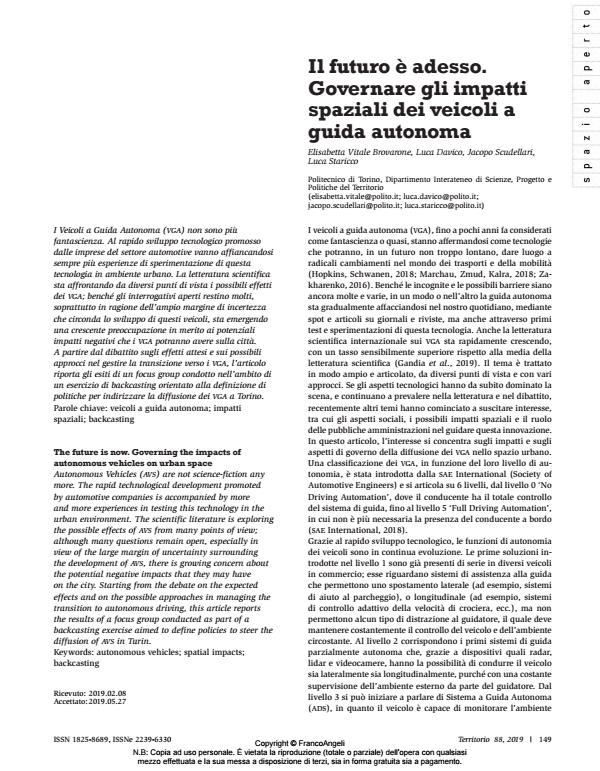Il futuro è adesso. Governare gli impatti spaziali dei veicoli a guida autonoma
Titolo Rivista TERRITORIO
Autori/Curatori Elisabetta Vitale Brovarone, Luca Davico, Jacopo Scudellari, Luca Staricco
Anno di pubblicazione 2019 Fascicolo 2019/88
Lingua Italiano Numero pagine 8 P. 149-156 Dimensione file 535 KB
DOI 10.3280/TR2019-088021
Il DOI è il codice a barre della proprietà intellettuale: per saperne di più
clicca qui
Qui sotto puoi vedere in anteprima la prima pagina di questo articolo.
Se questo articolo ti interessa, lo puoi acquistare (e scaricare in formato pdf) seguendo le facili indicazioni per acquistare il download credit. Acquista Download Credits per scaricare questo Articolo in formato PDF

FrancoAngeli è membro della Publishers International Linking Association, Inc (PILA)associazione indipendente e non profit per facilitare (attraverso i servizi tecnologici implementati da CrossRef.org) l’accesso degli studiosi ai contenuti digitali nelle pubblicazioni professionali e scientifiche
I Veicoli a Guida Autonoma (vga) non sono più fantascienza. Al rapido sviluppo tecnologico promosso dalle imprese del settore automotive vanno affiancandosi sempre più esperienze di sperimentazione di questa tecnologia in ambiente urbano. La letteratura scientifica sta affrontando da diversi punti di vista i possibili effetti dei vga; benché gli interrogativi aperti restino molti, soprattutto in ragione dell’ampio margine di incertezza che circonda lo sviluppo di questi veicoli, sta emergendo una crescente preoccupazione in merito ai potenziali impatti negativi che i vga potranno avere sulla città. A partire dal dibattito sugli effetti attesi e sui possibili approcci nel gestire la transizione verso i vga, l’articolo riporta gli esiti di un focus group condotto nell’ambito di un esercizio di backcasting orientato alla definizione di politiche per indirizzare la diffusione dei vga a Torino.
Parole chiave:Veicoli a guida autonoma; impatti spaziali; backcasting
- Planning policies for the driverless city using backcasting and the participatory Q-Methodology Soledad Nogués, Esther González-González, Dominic Stead, Rubén Cordera, in Cities 104535/2023 pp.104535
DOI: 10.1016/j.cities.2023.104535
Elisabetta Vitale Brovarone, Luca Davico, Jacopo Scudellari, Luca Staricco, Il futuro è adesso. Governare gli impatti spaziali dei veicoli a guida autonoma in "TERRITORIO" 88/2019, pp 149-156, DOI: 10.3280/TR2019-088021